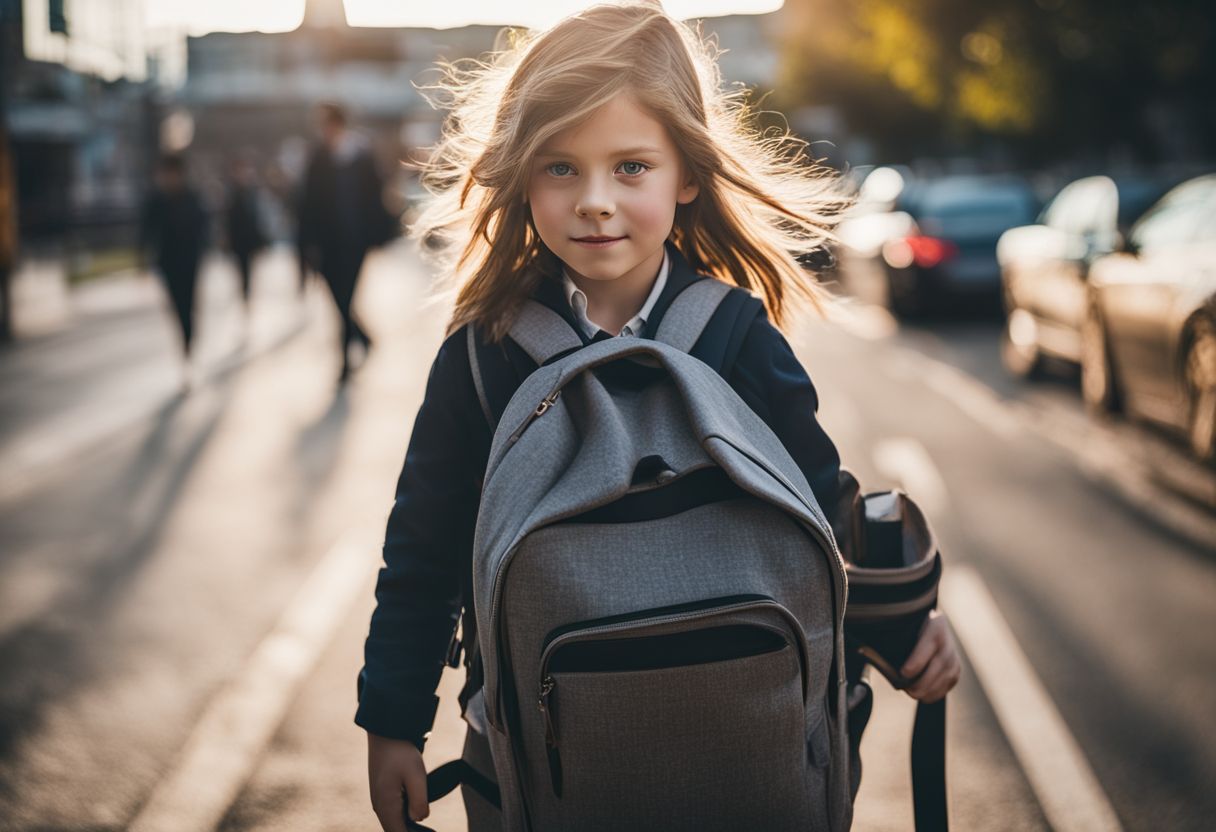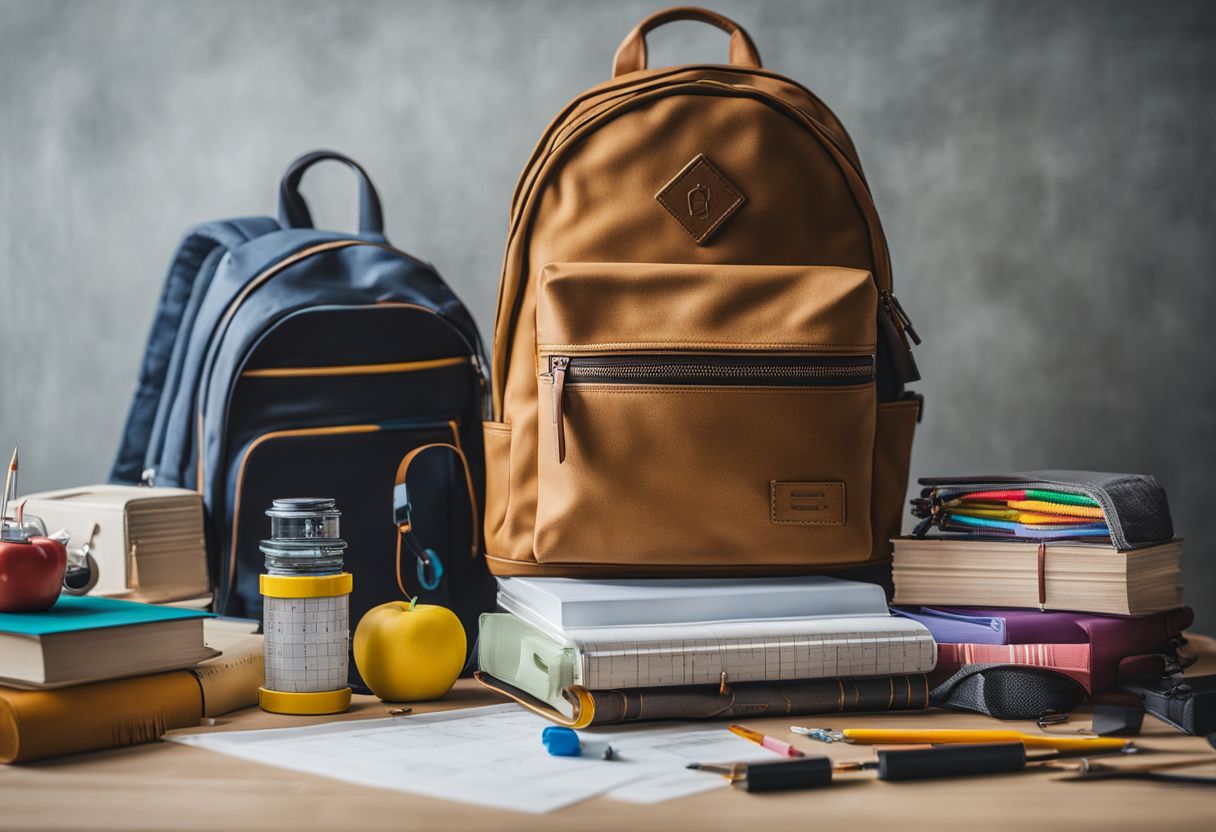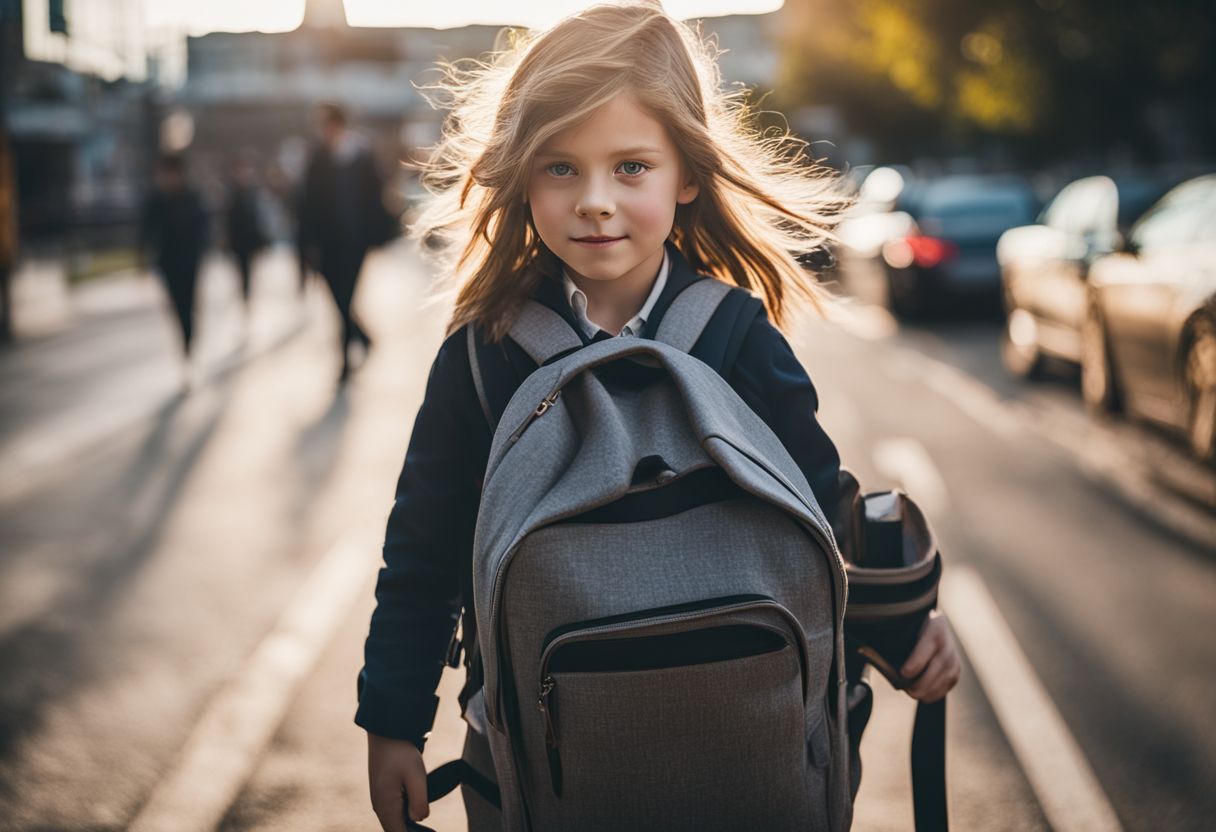Selecting the right rucksack for a child is more than just choosing a favorite color or pattern—it’s about safeguarding their developing spine. As an expert with years of experience in ergonomics and pediatric chiropractic care, I’ve seen firsthand how a poorly fitted backpack can lead to back pain, muscle strain, and even long-term posture issues in children.
It’s essential to address this common oversight which often goes unnoticed until it becomes a real problem.
Understanding that the ideal backpack should gently hug between two inches below the shoulders and up to four inches below the waistline sets an imperative standard for parents. This blog unlocks critical sizing insights for every age group that promise not only comfort but also vital spine health protection.
Let’s help our kids carry their world on their backs – safely! Keep reading; your child’s perfect fit awaits.
Key Takeaways
- Selecting the right-sized backpack for your child is crucial to prevent back pain, muscle strain, and long-term posture issues.
- Improperly sized or heavy backpacks can cause shoulder, back, and spine problems in children; it’s important not to exceed 10-15% of their body weight.
- Use recommended measurements and size charts to find a backpack that fits well – aim for two inches below the shoulders and up to four inches below the waistline. Adjustable straps are crucial as children grow.
- Consider ergonomic designs with padded straps, adjustability, durability, and safety features suitable for every age group from toddlers to teenagers.
Impact of Inappropriate Backpack Size on Children’s Spine

Improperly sized backpacks can strain a child’s shoulder blades and core and hip muscles, leading to potential long-term effects on their spine development.
Potential for strain and injury
Heavy or poorly fitting backpacks can hurt children. The bags may strain their shoulder blades and back muscles. This happens because the weight pulls on the child’s shoulders, causing them to lean forward.
When they lean too much, it puts extra pressure on their spine.
Carrying more than 10-15% of a child’s body weight is bad for their back. It pushes on discs between bones in the spine which can hurt or damage these discs over time.
Good sizing of kids’ backpacks helps prevent this problem. Next, let’s look at how to measure for a well-fitting backpack so your child stays safe and comfortable.
Long-term effects on posture and spine development
A backpack that’s too big or heavy can hurt a child’s back. Over time, this can change the way they stand and walk. Their spine might not grow right if they always carry a heavy load.
This means their back could be sore and curved, even when they are grown up.
Kids who sling their backpacks over one shoulder can end up leaning to one side. This lean might make their spine curve in a bad way. It is key to get them bags that fit well and don’t weigh too much.
This helps keep their backs straight and strong as they grow.
Choosing the right backpack is just the start. Next, let’s look at how to pick bags for kids of all ages, from tiny tots to big teens!
Sizing Guide for Children’s Backpacks

Ensure the proper fit by measuring your child’s back height and width. Use recommended measurements and size charts to find the right backpack for their age and size.
Finding the right height and width for proper fit
Choosing the right size backpack for your child is very important. It keeps their back safe and helps them carry their things comfortably. Here’s how to find a backpack that fits just right:
- Measure your child’s back length. Start at the base of the neck and measure down to the waistline.
- Check that the backpack is not wider than your kid’s torso. A pack too wide can cause discomfort.
- Use a size chart or take measurements. Look for one based on average sizes of kids.
- Aim for a backpack that fits within two inches below the shoulders and up to four inches below the waist.
- Pick a bag with adjustable straps. This lets you change the fit as your child grows.
Recommended measurements and size charts
When selecting a backpack for children, precise measurements ensure the perfect fit and optimal comfort. The appropriate size for a child’s backpack should be guided by their torso length and hip size. Below is a table with recommended measurements and size charts to assist parents and guardians in choosing the right backpack for their child.
| Age Range | Torso Length (inches) | Backpack Height (inches) | Backpack Width (inches) |
|---|---|---|---|
| Up to 2 years | 9-11 | 10-12 | 8-9 |
| Up to 6 years | 11-14 | 12-15 | 9-11 |
| Up to 12 years | 15-17 | 15-18 | 11-13 |
| Teenagers | 18+ | 18-20 | 13-15 |
Ensure the backpack is not wider than the child’s torso, and doesn’t hang too low on their back. After taking these measurements, adjust the straps for a snug, comfortable fit. Remember, a well-fitted backpack can significantly reduce the risk of long-term spine issues. With the right dimensions in mind, let’s delve into selecting the ideal kids’ backpack for every age group.
The Perfect Kids’ Backpack for Every Age
Choose a backpack with padded straps and a wide, adjustable waist belt for children up to 2 years old. Look for smaller, lightweight daypacks with child-friendly designs for kids up to 6 years old.
Opt for ergonomic school backpacks with reinforced bottoms and plenty of pockets for primary school children up to 12 years old. Consider durable, spacious daypacks with supportive back panels and multiple compartments for older kids and teenagers.
Backpacks for children up to 2 years old
Preschool backpacks are designed to be smaller for younger kids, providing a more comfortable and practical option for their smaller frames. When choosing a backpack for children up to 2 years old, consider the following:
- Size: Opt for lightweight, small-sized backpacks that fit snugly on their back without being too bulky or overwhelming.
- Material: Look for durable yet soft materials that are gentle on their skin but can withstand daily wear and tear.
- Straps: Choose backpacks with padded shoulder straps to distribute weight evenly and prevent strain on their delicate shoulders.
- Design: Select backpacks with fun colors, shapes, and patterns that appeal to young children, making the backpack-wearing experience enjoyable for them.
- Safety Features: Prioritize backpacks with secure closures and reflective elements to enhance visibility, ensuring their safety during outdoor activities.
- Adjustability: Opt for backpacks with adjustable straps that can grow with your child to maintain a proper fit as they develop and grow.
Backpacks for children up to 6 years old
Children aged up to 6 years need backpacks that fit them properly and are comfortable to wear. Here’s what you should consider when choosing a backpack for children in this age group:
- Ensure the backpack is lightweight and proportionate to the child’s size. This prevents strain on their developing muscles and spine.
- Look for padded shoulder straps that are adjustable. This ensures a proper fit and comfort as the child grows.
- Choose a backpack with wide, padded back support to promote good posture and distribute weight evenly.
- Opt for a backpack with multiple compartments to help organize small items like snacks, toys, or diapers.
- Consider fun and colorful designs that appeal to young children, but prioritize safety and ergonomic features.
Backpacks for primary school children up to 12 years old
When choosing backpacks for primary school children up to 12 years old, it’s crucial to consider their proper fit and functionality. Here are important factors to keep in mind:
- Size: Ensure the backpack is proportionate to the child’s body size. It should not be too large or too small, but rather fit comfortably without causing strain.
- Weight Distribution: Look for backpacks with padded straps and a waist belt to evenly distribute the weight of the bag, reducing strain on the child’s back.
- Organizational Features: Opt for backpacks with multiple compartments to help children stay organized and prevent carrying unnecessary items that could add weight.
- Durability: Choose durable materials that can withstand rough handling and daily wear and tear, ensuring the backpack lasts throughout the school year.
- Expression and Style: Consider designs that allow children to express their personal style while still adhering to comfort and functionality.
- Safety Features: Look for reflective materials or patches on the backpack to enhance visibility, especially during darker hours when traveling to and from school.
- Adjustability: Seek backpacks that offer adjustable straps and additional support features, accommodating a growing child’s changing body size and needs.
Backpacks for older kids and teenagers
Choosing the right backpack for older kids and teenagers is crucial for their comfort and health. Here are some important factors to consider:
- Capacity: Ensure the backpack has a capacity suited to the child’s age, height, and weight. Ideal sizes range between 16-18 liters for preschoolers.
- Storage Features: Look for plenty of storage room inside and extra loops on the outside for added convenience.
- Materials and Design: Consider durable materials, ergonomic design, and safety features to provide adequate support.
- Adjustability: Opt for backpacks that can be adjusted to cater to growing children, ensuring a proper fit as they develop.
- Expert Recommendations: Seek advice from professionals or trusted sources like Alpinetrek for guidance on choosing and using backpacks.
- Maintenance: Educate children on weight limits and proper load guidelines while emphasizing regular cleaning and maintenance for durability.
- Comfortable Handling: Prioritize ease of use with child-friendly handling features that enhance practicality while minimizing strain.
Factors to Consider When Choosing a Backpack
Consider the materials and child-friendly handling to ensure durability and comfort for your child. Discover the key features that make a backpack safe and functional for kids of all ages.
Read on to find out more!
Materials and child-friendly handling
The materials used in children’s backpacks should be durable yet lightweight to prevent adding unnecessary weight. Look for child-friendly features like padded shoulder straps and back panels to provide comfort and support during wear.
Additionally, opt for backpacks with smooth zippers and easy-to-use buckles to promote independent use by the child.
When choosing a backpack, consider the materials used in its construction and ensure they are easy to clean, sturdy enough to withstand daily use, and free from any potentially harmful substances.
Design and safety features
When choosing a backpack for your child, it’s crucial to consider the design and safety features. Look for padded shoulder straps and a cushioned back panel to provide comfort and support.
Adjustable straps ensure that the backpack fits snugly against your child’s body, reducing strain. Additionally, reflective materials on the backpack can improve visibility, especially when children are walking or cycling to school.
Another important design feature is multiple compartments, which distribute weight more evenly and prevent items from shifting around inside the backpack. It’s also beneficial to choose a backpack with durable and water-resistant materials to protect belongings from unexpected weather conditions, ensuring longevity and practicality in various situations.
To promote safety, opt for backpacks with sturdy zippers and reinforced seams that can withstand daily wear and tear. Finally, selecting a size-appropriate backpack will prevent overloading and reduce strain on your child’s back.
Adjustability for growing children
Ensure that the backpack has adjustable straps for a comfortable fit as your child grows. Look for those with adjustable shoulder straps and chest or waist belts to distribute weight evenly and prevent strain on the back.
A good backpack should also have multiple compartments, allowing you to balance the load effectively.
Consider choosing a backpack with additional features like padded back support, reflective strips for visibility, and water bottle pockets to promote safety and convenience. These features can make a significant difference in how comfortably your child carries their school supplies each day.
When selecting a backpack for your growing child, prioritize adjustability and extra comforts such as padding and ergonomic design to avoid strain or injury over time. By focusing on these details when choosing a backpack, you can help your child maintain good posture while carrying their essentials throughout the school day.
Proper Care and Maintenance of Children’s Backpacks
Teach kids to carry only what they need and to avoid overloading their backpacks, as excessive weight can strain their spine and shoulders. Regularly check for signs of wear and tear, and encourage proper storage to prolong the life of the backpack.
Weight limits and load guidelines
Children should carry no more than 10% to 20% of their body weight in their packs, as recommended by doctors and physical therapists. The American Academy of Pediatrics also suggests that a backpack weigh no more than 5% to 10% of a child’s weight. Here are some detailed guidelines for weight limits and load when it comes to children’s backpacks:
- The backpack for a 60 – pound child should weigh less than nine pounds, ensuring that it stays within the recommended weight limit.
- Epidemiologic, physiologic, and biomechanical data strongly support the suggested weight limit of 10% to 15% body weight for children’s backpacks.
- To maintain a healthy balance, make sure that the weight inside the backpack is distributed evenly to prevent strain on your child’s back.
- Choose lightweight materials for the backpack to help keep the overall load as light as possible without compromising durability.
- Regularly check your child’s backpack weight using a scale to ensure it does not exceed the recommended limit based on their body weight.
Regular cleaning and maintenance for durability
To ensure the durability of your child’s backpack, follow these tips:
- Wash fabric backpacks regularly by hand or in the washing machine to prevent dirt and stains from accumulating.
- Clean leather or leather – trimmed backpacks as you would clean any leather item to maintain their appearance and quality over time.
- Remove any stains promptly to keep the backpack looking fresh and vibrant for your child’s everyday use.
- Keep an eye on weight limits and load guidelines to prevent excessive strain on the backpack’s material and stitching.
- Routinely inspect the backpack for signs of wear and tear, such as loose threads or stretched fabric, and address them promptly to prolong its lifespan.
Expert tips for choosing and using backpacks from Alpinetrek
When it comes to choosing and using backpacks from Alpinetrek, there are essential tips to ensure your child’s comfort. Firstly, select a backpack that matches the child’s back measurements for an ergonomic fit, preventing strain or discomfort during use.
Look for backpacks made with durable materials suitable for children and featuring child-friendly handling such as easy-to-open zippers and lightweight construction. Ensure the chosen backpack has adjustable straps designed to suit a child’s size and provide comfortable support while distributing weight evenly.
Additionally, consider safety features like reflective strips for visibility in low light conditions.
Conclusion
In conclusion, finding the right-sized backpack for your child is crucial for their spine health and overall comfort. The sizing guide provided here offers practical and efficient ways to ensure a proper fit.
Have you considered the impact of applying these strategies on your child’s posture and spinal development? Remember that choosing the correct backpack size can make a significant difference in your child’s well-being.
Explore further resources or guidance from reputable brands to continue enhancing your knowledge in this area. Always prioritize ergonomics and comfort when selecting a rucksack for your children – their growing bodies will thank you!
FAQs
1. Why is the right rucksack size important for children?
The right rucksack size helps prevent back pain in children by protecting their intervertebral discs from damage and makes carrying school bags comfortable.
2. What can happen if a child’s backpack is too big or heavy?
If a child’s backpack is too big or heavy, it can cause reversible damage to their back and lead to back pain.
3. What should I look for in an ergonomic backpack for my child?
Look for an ergonomic backpack that fits well on your child’s back and has straps that adjust so it does not hang too low. It should also be able to hold all their notebooks and other school items comfortably.
4. Can a chiropractor help with backpack-related problems?
Yes, a chiropractor can give advice about human factors like proper bag size, weight, and fitting which are important to keep kids’ backs healthy when using school bags.

